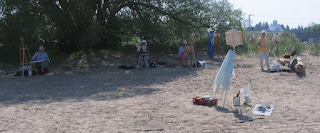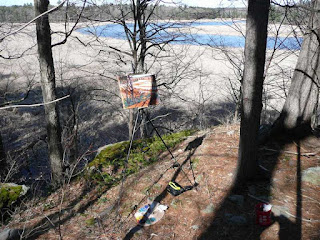 From Friday, June 9th, 2006 - This is the fourth demonstration piece for the second week of teaching at the Southampton Art School. I asked the group what they wanted to have demonstrated. They all said waves. It was most appropriate given the title of the course. As a result I headed down the road to overlook Lake Huron to the northwest. This put me and the group right in the blast of the cold air advection. One girl darn near froze. The twelve participants were huddled up behind me. I let all of the enthusiasm for plein painting out and this is what resulted. It was an experience that I won't forget.
From Friday, June 9th, 2006 - This is the fourth demonstration piece for the second week of teaching at the Southampton Art School. I asked the group what they wanted to have demonstrated. They all said waves. It was most appropriate given the title of the course. As a result I headed down the road to overlook Lake Huron to the northwest. This put me and the group right in the blast of the cold air advection. One girl darn near froze. The twelve participants were huddled up behind me. I let all of the enthusiasm for plein painting out and this is what resulted. It was an experience that I won't forget.Unconsciously I painted the surface of the lake curved as though the earth was a smaller sphere. You can see the curvature on the horizon. That is what I saw. The streets of stratocumulus were aligned with the wind direction in the unstable boundary layer. There is a lot of meteorology in this painting. It is interesting how the combination of wind and current even shapes the shoreline.
The view is northwesterly with streets of turbulent stratocumulus and lots of waves. A huge cedar log was up on the beach in 2006. That very same log was still there in 2014.
http://fineartamerica.com/featured/making-waves-in-oil-phil-chadwick.html
|
















